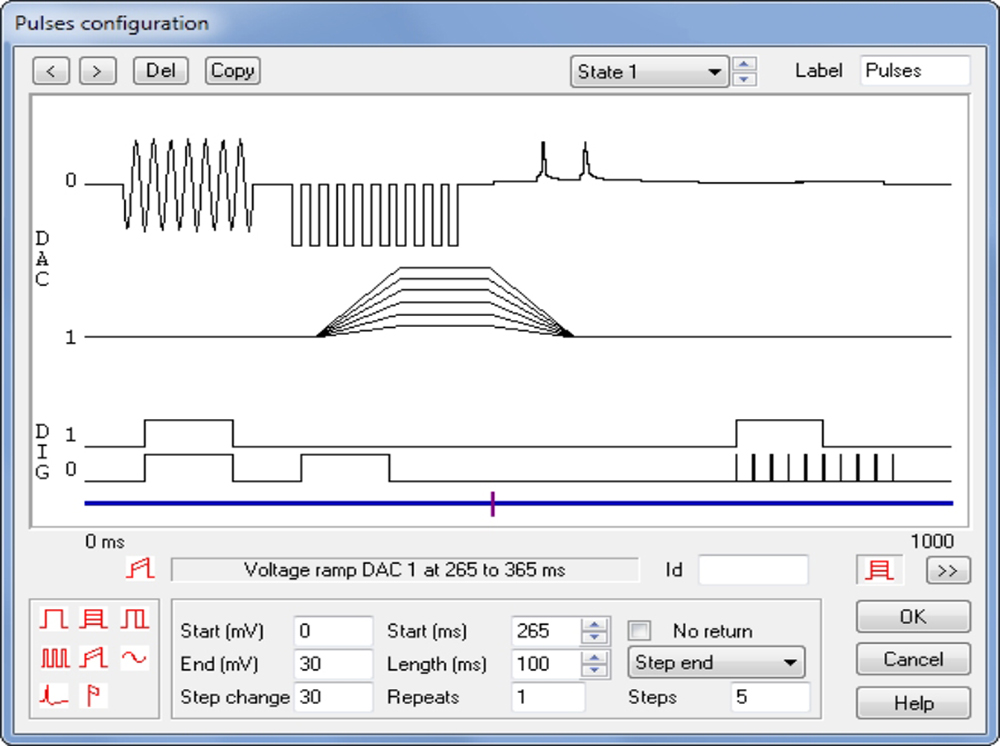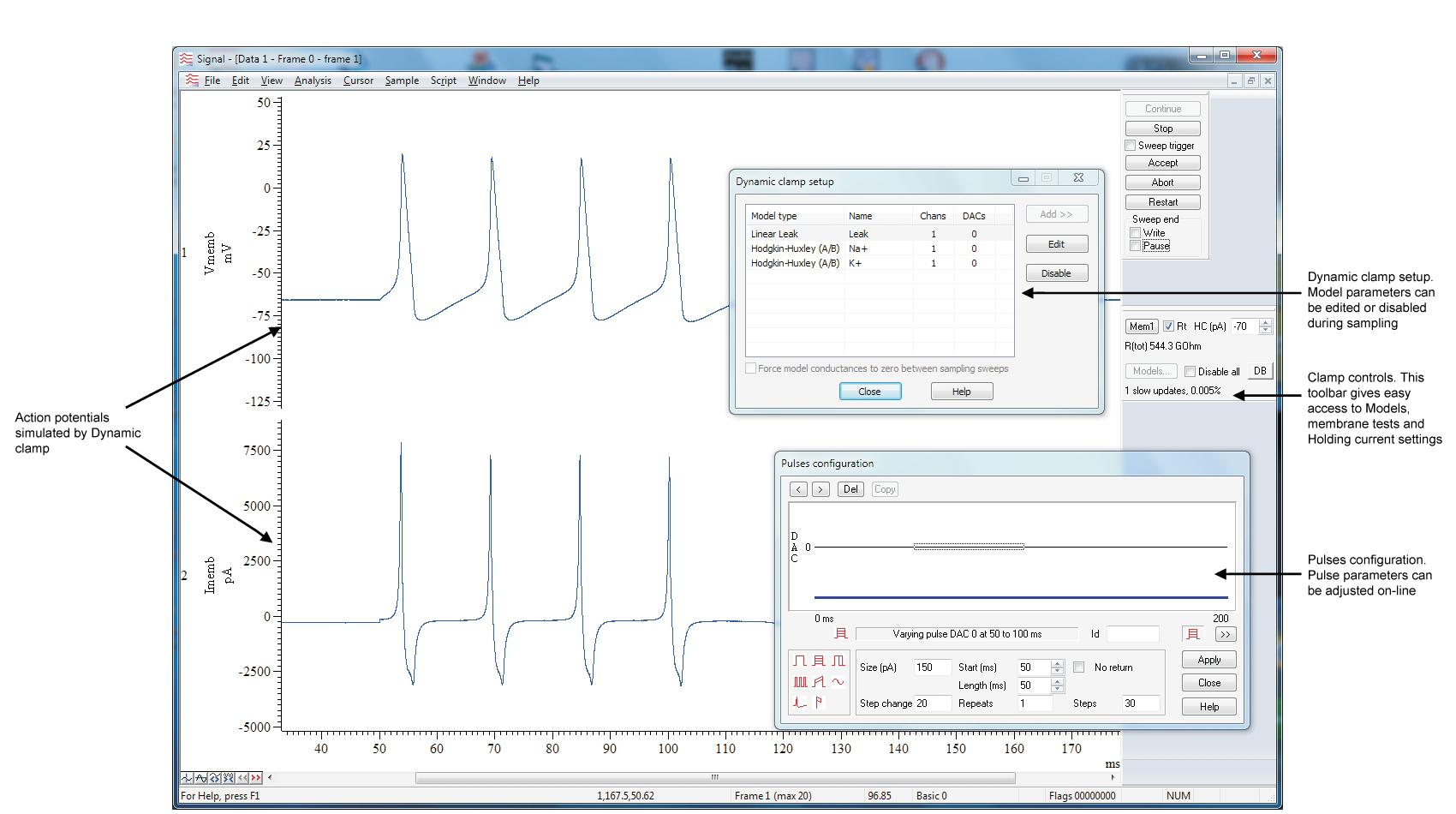Signal is a sweep-based data acquisition and analysis package. Its uses range from a simple storage oscilloscope to complex applications requiring stimulus generation, data capture, control of external equipment and custom analysis. This flexibility makes it ideal for a wide range of applications including transient capture, patch and voltage clamp, LTP studies and evoked response.
The powerful data capture and time-saving analysis functions of Signal together with one of the CED 1401 family of laboratory interfaces make an extremely flexible and cost effective addition to any laboratory.
General Features
Patch Clamp Electrophysiology Specific Features
Acquisition Using a CED 1401
Signal incorporates a powerful sequencer function for generating digital and analogue outputs for stimulus control. Sequences are run within the 1401 interface to ensure highly accurate timing independent of the host PC operating system. There are two methods available for specifying outputs.
The graphical pulse editor covers the majority of stimulus requirements in an easy to use drag and drop environment where you build up to 256 sets of up to 500 pulses linked to the multiple states system. Outputs are fixed or they can change amplitude and duration on repeats. You can also modify the outputs while sampling continues.
If your requirements cannot be entirely met with the pulse editor you can define your outputs as a text sequence of instructions. This makes it possible to control the sequence interactively or by using the script language running on the host PC to pass variables and tables of values to the 1401. It also enables you to produce pulse protocols either time-locked to the recording frames or free running. Further experiment control options including communication through serial lines are also available using the script language.
Signal for Windows incorporates many powerful features for whole cell and single channel experiments that make it ideal for electrophysiological recording. Familiar terms, and easily set up protocols for standard requirements enable the user to get started quickly usingSignaland aCED Power 1401 data acquisition interface. Signal also incorporates an import function allowing you to analyze data from other recording systems.
Signal can easily all of the stimuli needed, including pre-recorded waveforms to perform voltage and current clamp experiments. In addition, Signal combined with the Power1401-3 data acquisition system are the easiest way to implement Dynamic Clamping in your research protocols.
Multiple sets of stimuli can be stored in one sampling configuration and selected manually or automatically sequenced. Signal can perform on-line measurement of seal and membrane resistance. Leak subtraction and I/V plots can be generated in real time or during offline analysis. Signal also provides mathematical functions to enable complicated curve fitting to waveform data and I/V plots.
Telegraph communication from theA-M Systems Model 2400 Patch Clamp Amplifiersca允许信号设置正确le collected data and send appropriate control voltages to the amplifier for complete control of the recording preparation
Signal can perform complicated curve fitting to your collected measured data, including Exponential, Gaussian, Polynomials, and Sigmoid curve. All data can be plotted and exported in tabular or graphical forms.
Signal and the Power1401-3 data acquisition system are the easiest way to implement Dynamic Clamping in your research program. Signal includes a fully integrated, easily configurable, high-performance dynamic clamping system. This advanced feature makes the technique readily available to researchers who do not have access to complex customized hardware and software, by providing a professionally designed, maintained and supported package that is usable by all, at a low cost.
In the dynamic clamp technique, a typically nonlinear feedback system delivers current to a cell to represent the actions of virtual ion channels, allowing ion channels or synapses to be simulated or the actions of existing channels to be cancelled.
When used in conjunction with the Power1401-3, Signal can be the bases of your dynamic clamp environment. Standard embedded hardware-based dynamic clamp systems offer feedback that is fast and precisely timed, but these systems are often expensive and sometimes inflexible. PC-based systems, on the other hand, allow more complex feedback, but real-time performance can be poor. The CED Signal dynamic clamp system gives you the best of both worlds. All real-time aspects of the system are executed by the Power1401’s fast embedded processor using pre-calculated lookup tables and optimized floating-point arithmetic, with the feedback calculations triggered by the ADC sampling for maximum stability. This software-based design is quick yet still provides great flexibility. The non-real-time aspects of the system are handled by the controlling PC to allow simplicity and ease of use.
The result: a dynamic clamp system integrated into the standard Signal data acquisition software that outperforms generally available dynamic clamp systems, at a reasonable cost.
Signal Dynamic clamping requires a CED Power1401-3 and a PC with Windows NT 2000, Windows XP, Windows Vista, Windows 7, Windows 8 or Intel Macintosh running Windows. Both 64-bit and 32-bit OS versions are supported. We recommend the computer has a minimum of 2GB of RAM.


| Catalog # | Name | Price | |
|---|---|---|---|
|
953040 |
Single License |
Price:$3,150.00
|
|
|
953060 |
Additional License |
Price:$1,050.00
|
|